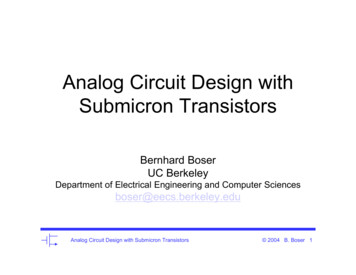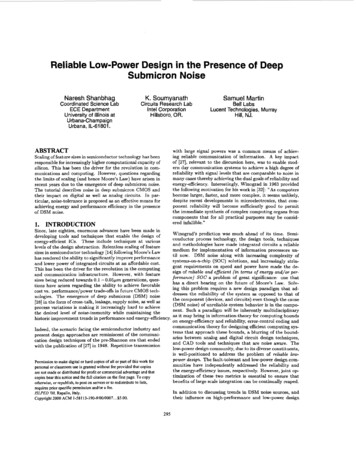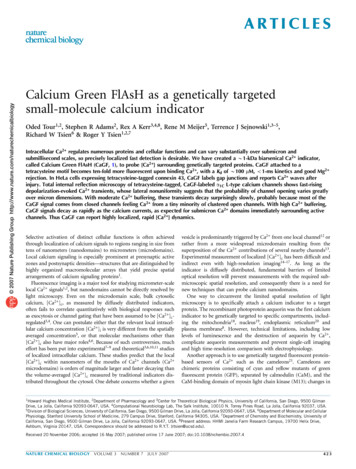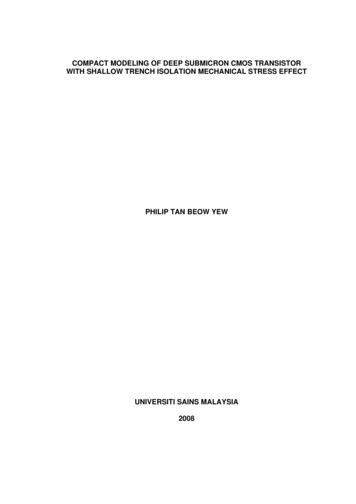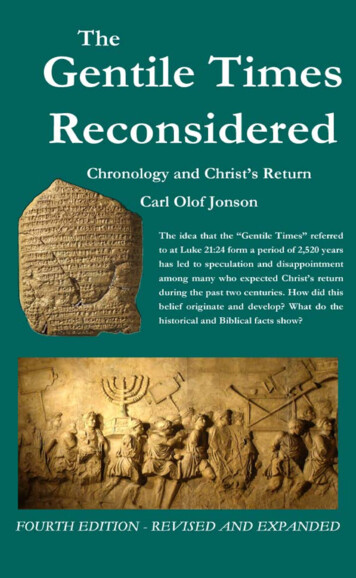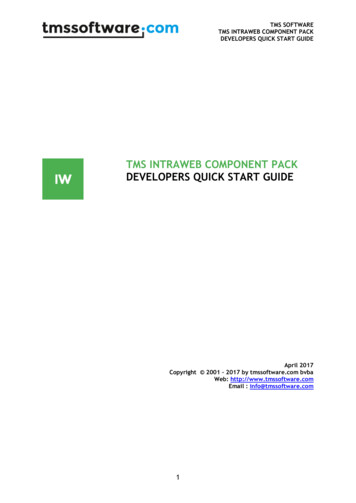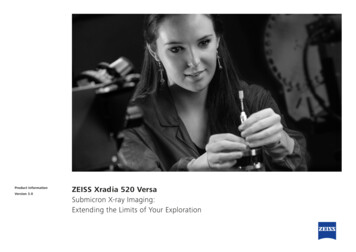
Transcription
Product InformationVersion 3.0ZEISS Xradia 520 VersaSubmicron X-ray Imaging:Extending the Limits of Your Exploration
Submicron X-ray Imaging: Extending the Limits of Your Exploration›In Brief›The Advantages›The Applications›The System›Technology and Details› ServiceUnlock new degrees of versatility for your scientific discovery and industrialresearch with the ZEISS Xradia 520 Versa 3D X-ray microscope; the mostadvanced model in the Xradia Versa family. Building on industry-best resolutionand contrast, Xradia 520 Versa expands the boundaries of non-destructiveimaging for breakthrough flexibility and discernment critical to your research.Innovative contrast and acquisition techniques free you to seek – and find –what you have never seen before. Move beyond exploration and achievediscovery.2
Simple. More Intelligent. More Integrated.›In Brief›The Advantages›The Applications›The System›Technology and Details› ServiceAchieve New Degrees of FreedomExperience Performance BeyondSupport Your Research with theTraditional Micro-CTPremier 4D / In Situ SolutionUse the industry’s most comprehensive submicronZEISS Xradia 520 Versa enables unprecedentedNondestructive 3D X-ray microscopes uniquelyX-ray imaging solution for advanced scientific andlab-based exploration for a diverse array ofcharacterize the microstructure of materialsindustrial research. Xradia 520 Versa offers manyapplications, sample types and sizes. Xradia Versain native-like environments—in situ—as wellindustry-firsts: Compositional contrast providessolutions help you extend your research beyondas the evolution of properties over time (4D).unprecedented discernment of the materialsthe limits of basic projection-based micro-andLeverage RaaD with Xradia 520 Versa toyou study and their characteristics. Diffractionnano-CT systems. Where traditional tomographymaintain the highest resolution across largecontrast tomography unlocks 3D crystallographicrelies on a single stage of geometric magnifi-working distances, accommodating samplesinformation in your lab. The name says it all:cation, Xradia 520 Versa features a uniquecontained within environmental chambersLabDCT is the first laboratory-based analyticaltwo-stage process based on high resolutionand high-precision in situ rigs. Additionally,modality for computed tomography. Extended fieldoptics. Our breakthrough Resolution at a Distancethe In situ Interface Kit for Xradia Versaof view tomography acquisition techniques,(RaaD) provides true spatial resolution ofwill optimize your set-up and operation,including the optional Flat Panel Extension (FPX),0.7 μm with a minimum achievable voxel sizeproviding you with the results you're lookingfurther enhance the speed and accuracy withof 70 nm. Additionally, the optional FPX enablesfor faster and more easily.which you can image samples of distinctiverapid macroscopic scans of very large samples,proportions. Building on Xradia synchro tron-caliberproviding a roadmap to high resolution scans.optics and architecture, the advanced Dual Scanof interior regions of interest.Contrast Visualizer (DSCoVer) and High AspectRatio Tomography (HART) capabilities provideyou with features that deliver unrivaled versatilityfor your research and exploration.100 µm200 µmLabDCT 3D imaging of grain orientations in aluminum alloy(IPF (inverse pole figure) colored). Image Courtesy of: TU DenmarkFPX: Extend field of view over multiple length scales when imagingintact lithium batteriesAccommodate a variety of stages with your in situ kit.3
XRM Detector TechnologyYour Insight into the Technology Behind ItXRM Detector Technology›In BriefBenefit from Non-destructive, High Resolution 3D ImagingToday’s premier research and technology developX-ray microscopy plays a vital role in your imaging›The Advantagesment requires three-dimensional insight intoworkflow, delivering high resolution and contrastsubjects in their native states and as they evolvewithout destroying valuable samples, preservingover time. World-lead ing research and develop-them for future use. Adding a non-destructive stagement facilities, universities, synchrotrons, nationalto the traditional workflow complements electronand private labs have deployed X-ray microscopyand optical techniques, enabling you to quickly(XRM) to meet the growing need for flexible,identify regions of interest for further study at higher3D/4D imaging at high resolution.resolution but ultimately destructive techniques.›››The ApplicationsThe SystemTechnology and Details› ServiceSelect your objective to adjust resolution and field of view (FOV)without repositioning your CDCCDZEISS Xradia Versa dual stage magnification technology uniquely enables you to maintain high resolution across large working distances (knownas Resolution at a Distance, or RaaD). This capability is rooted in the system's synchrotron heritage, using a patented detector system withscintillator-coupled visible light optics.4
Your Insight into the Technology Behind ItIn Brief›The Advantages›The Applications›The System›Technology and Details› ServiceZEISS XRM: Architected for Your AdvantageXradia Versa architecture natively uses a two-stageThe projected image impinges on a scintillator,magnification technique to uniquely providewhich converts X-rays to visible light, and is subse-you with submicron resolution at large workingquently magnified by an optical objective beforedistances, known as resolution at a distancereaching the detector. Add the optional flat panel(RaaD), for a large range of sample sizes. Sampleextension (FPX) to your system to further increaseimages are initially enlarged through geometricits versatility. This combination of detector designsmagnification as they are in conventionalallows the widest range of sample sizes and typesmicro-CTs.to be studied efficiently and accurately.Flat PanelSampleSourceGeometric Magnification (a b) / aConventional Micro-CT Architecture14DetectorGeometric MagBased MicroCTsResolution rapidlydegrades withincreasingsample size1210Resolution (µm)›8SampleSourceOpticalMagnificationGeometric Magnification (a b) / aZEISS XRM Two-stage Magnification Architecture64Xradia Versa2005101520253035404550Clearance around sample rotation axis (mm)High resolution is maintained for large samples5
Your Insight into the Technology Behind It›In Brief›The Advantages›The Applications›The System›Technology and DetailsAchieve True Spatial ResolutionXradia Versa solutions deliver powerful 3DSpatial resolution accounts for critical charac-X-ray imaging for your research requirements,teristics such as X-ray source spot size, detectormaintaining true submi cron spatial resolutionresolution, magnification geometry, andacross varying distances, sample sizes, andvibrational, electrical and thermal stability.environments. ZEISS specifies XRM on trueYou will hear other terms, such as "voxel",spatial resolution, which is the most meaningful"spot size", "detail detectability", and "nominalmeasurement of a microscope's performance.resolution", but they do not convey an imagingsystem's full performance capabilities.› ServiceSpatial resolution refers to the minimumseparation at which a feature pair can beresolved by an imaging system. It is typicallymeasured by imaging a standardized resolutiontarget with progressively smaller line-space pairs.True spatial resolution of 0.7 μm and a minimum achievablevoxel size of 70 nm.6
Your Insight into the Technology Behind It›In Brief›The Advantages›The Applications›The System›Technology and Details› ServiceGain An Edge In ContrastYour imaging requires superior contrast capa-In addition, the tunable propagation phasebilities to reveal details necessary to accuratelycontrast measures the refraction of X-ray photonsvisualize and quantify features. Xradia Versaat material transitions to allow you to visualizedelivers flexible, high contrast imaging for evenfeatures displaying little or no contrast duringyour most challenging materials—low atomicabsorption imaging. Now, diffraction contrastnumber (low Z) materials, soft tissue, polymers,tomography (LabDCT) reveals 3D crystallographicfossilized organisms encased in amber, andinformation directly from polycrystalline materi-other materials of low contrast.als such as metals and alloys. This enables you125 µm125 µmto combine crystallographic information withZEISS's comprehensive approach employs pro-absorption or phase contrast tomography whereprietary enhanced absorption contrast detectorsprecipitates or defects are revealed.Pear imaged with absorption contrast – no visibility of cellwalls (left), and pear imaged with phase contrast, showingdetails of cell walls in normal cells and stone cells (right).that achieve superior contrast by maximizingcollection of low energy photons while minimizing collection of contrast-reducing highenergy photons.250 µmLabDCT provides non-destructive 3D grain imaging for mappingorientation and microstructure (Sample: Armco Fe, diameter1 mm. Reconstructed volume (color image), diffraction pattern(black and white image). Sample courtesy of: University ofFlorida; Burton R Patterson7
Your Insight into the Technology Behind It›In Brief›The Advantages›The Applications›The System›Technology and Details› ServiceOptimize Contrast for MaximumDiscernibilityAlThe innovative Dual Scan Contrast Visualizerresulting datasets, assures you will achieve(DSCoVer) provides flexible side-by-side tuningoptimum contrast for the material of interestof two distinct tomographies. This enablesand enable you to define repeatable researchcompositional probing for features normallyparameters.DSCoVer takes advantage of howindistinguishable in a single scan, allowing youX-rays interact with matter based on effectiveto seamlessly and easily collect the data requiredatomic number and density. This provides youfor dual energy analysis. Imaging a sample at twowith a unique capability for distinguishing,different X-ray operating source voltages, suchfor example, mineralogical differences withinas low energy (LE) or high energy (HE) or in tworocks as well as among difficult-to-discerndifferent states, aligning then combining thematerials such as silicon and aluminum.SiO2Si660 µmSegmentation of Al particles using the 2D histogram.DSCoVer results of combined low energy (LE) and high energy(HE) XRM datasets.375 µmDual Scan Contrast Visualizer (DSCoVer) InterfaceVisualization and analysis of the 3D segmented Al datasetfrom a combined LE and HE dataset in DSCoVer. Using the2D histogram, Al (green) and Si (brown) were segmentedfrom the matrix over the full 3D dataset. (Sample is 3 mm indiameter)8
Your Insight into the Technology Behind It›In Brief›The Advantages›The Applications›The SystemAchieve Higher Throughput –Get a Faster Time to ResultsThe innovative High Aspect Ratio TomographyYou can also tune HART to emphasize higher(HART) mode on Xradia 520 Versa provides youthroughput or better image quality, therebywith higher throughput imaging for your flatpotentially accelerating image acquisitionsamples such as those found with semiconductorspeed by 2X.packages and boards. HART enables you to›Technology and Details› Servicevariably space projections so that you collectThis faster acquisition mode is in addition to afewer pro jections along the broad side of a flatpowerful dual GPU workstation that acceleratessample and more along the thin side. A wealthimage reconstruction time by up to 40%.of 3D data is provided by these closely-spacedlong views versus less densely-spaced shortAdd the optional flat panel extension (FPX) toviews, maximizing the information densityachieve higher throughput (2-5X) on very largeduring acquisition.samples (up to 10X).HART – 2 hours125 µmHART projection spacing and density optimizedfor feature-rich short side.Non-HART – 4 hours125 µmHART (left) vs without-HART 64 Gb Flash Chip. Same or better quality image in half the scan time.9
Your Insight into the Technology Behind It›In Brief›The Advantages›The Applications›The System›Technology and Details› ServiceNow It’s Even Easier to ImageChallenging SamplesThe Automated Filter Changer (AFC) is easy to useThe AFC houses these filters and allows yourand facilitates features such as DSCoVer and in situselection to be programmed and recorded for eachapplications on the Xradia 520 Versa instrument.recipe with the Scout-and-Scan Control System.Researchers commonly use source filters to tuneWhen you don't need a source filter at all, therethe X-ray energy spectrum and every Xradiais a convenient cut-out on the AFC to allow your520 Versa comes with a standard set of 12 filters.samples to move even closer to the sourceIn addition to the standard range of filters, you willfor higher throughput.find 12 additional filter slots on the AFC to allowyou to use custom source filters, such as filterscomposed of different materials or thicknesses.The Automated Filter Changer offers 12 standard filters withroom for 12 more custom filters.10
Your Insight into the Technology Behind It›In Brief›The Advantages›The Applications›The System›Technology and Details› ServiceFlexibly Image Larger SamplesWide Field Mode (WFM) provides you with eitherThis additional imaging flexibility is availablean extended lateral field of view for imaging largeon Xradia 520 Versa 0.4X and 4X objectives.sample types or higher resolution using the standard field of view, both in a single tomography.Combining WFM with the existing VerticalFor larger samples, the lateral field of viewStitching feature, which joins separate tomogra-is approximately twice as wide as the standardphies vertically into a taller single tomography,mode for the same voxel size providing youenables you to image large samples that are bothwith 3D volume more than three times larger.wider and taller than the standard field of view.Using standard field of view, WFM provides youwith nearly twice the number of voxels.Image large samples such as this 6 inch stereo speaker.1 mmAchieve higher resolution (2X voxel) in standard field of view mode.11
Your Insight into the Technology Behind ItUse Our Super Simple Control System›In Brief›The Advantages›The ApplicationsScout-and-Scan Control System, an efficient›The Systemworkflow environment that allows you to easily›Technology and Detailsto Create Efficient WorkflowsAll of the features introduced by Xradia 520Versa are seamlessly integrated within thescout a region of interest and specify scanning› Serviceparameters. The easy-to-use system is ideal fora central lab-type setting where your usersmay have a wide variety of experience levels.The interface maintains the flexibility for whichXradia Versa systems are known, enabling youto set-up scans even more easily. Scout-and-Scansoftware also offers recipe-based repeatability,which is especially useful for your in situ and4D research, and enables you to have greatercontrol and efficiency for future work.Set, Load, Scout, Scan, Run. It’s that simple.Scout-and-Scan Advantages Internal camera for sample viewing Recipe control (set, save, recall) Parameter flexibility and feedback Multiple samples with Autoloader option Stitch multiple volumes easily with vertical stitch Micropositioning capability with a simplemouse click12
Expand Your Possibilities›In Brief›The Advantages›The Applications›The System›Technology and Details› ServiceLabDCT – Unlocking CrystallgraphicInformation in your LabWith LabDCT, ZEISS brings you the first-ever Combine 3D grain orientation with 3D micro- Investigate microstructure evolution with 4Dlaboratory-based diffraction contrast tomographystructural features such as defects or precipi-imaging experiments: LabDCT extends metalsimaging module. This unique grain imagingtates you have observed in tomography:research to 3D—and on to 4D with routineanalytical technology enables non-destructiveWhere absorption or phase contrast tomo-tool access for longitudinal studies such asmapping of orientation and microstructure in 3D.graphy lack information on grain orientationcorrosion. Compared to the synchrotron, beingNo longer confined to conventional 2D metallo-or other details of your material’s microstruc-able to expose your samples to environmentsgraphy investigations, direct visualization of 3Dture, you can combine them with LabDCT.in the microscope across days, weeks or evencrystallographic grain orientation opens up a newYou will see new possibilities for characterizingmonths is a unique strength of laboratory-dimension in the characterization of metal alloysdamage, deformation and growth mecha-based XRM experiments.and polycrystalline materials.nisms—or even to couple with modeling. Complement your grain imaging with 3D grainacmorphology: Routinely acquire grain statisticson larger volumes at faster acquisition times.Crystallographic information provided byLabDCT lets you supplement other analyseslike EBSD or synchrotron methods.b250 µmDirect visualization of an aluminum-copper (Al – Cu) alloy, acquired with LabDCT. The 3D crystallographic information of the Al – Cu grainboundaries (a) is combined with the information of the grain shape (b) in an overlay: (c) a virtual cross-section through the center of the 3DXRM image data stack is a combination of both (a) and (b).13
Expand Your Possibilities›In Brief›The Advantages›The Applications›The SystemLabDCT – How it worksLabDCT Advanced Imaging ModuleLabDCT is a fully integrated analytical module. Dedicated hardware: apertures, beamstopThe sample is illuminated through an aperture Integrated acquisition with Scout and Scanin front of the X-ray source. Both the sample GrainMapper3D advanced and interactiveabsorption and diffraction information arecrystallographic reconstruction softwarerecorded with a high resolution detection system. Dedicated high performance workstationA beamstop is added to the set-up to block out›Technology and Details› Servicethe direct beam and to enhance the contrastof the diffraction signal. 3D crystallographicinformation (e.g. grain size, shape, position andorientation) are reconstructed using GrainMapper3D software.300 µmDetectorSodium chloride embedded in epoxy (energetic material proxy):LabDCT orientation match {100} cleave tic of the LabDCT setup.14
Expand Your Possibilities›In Brief›The Advantages›The Applications›The System›Technology and DetailsIncrease Your Sample Handling EfficiencyMaximize your instrument’s utilization byminimizing user intervention with the optionalAutoloader, available for all instruments in theZEISS Xradia Versa series of submicron 3D X-raymicroscopes. Reduce the frequency of userinteraction and increase productivity by enabling› Servicemultiple jobs to run. Load up to 14 samples,queue, and allow to run all day, or off-shift.The software provides you with the flexibilityto re-order, cancel and stop the queue to inserta high priority sample at any time. An e-mailnotification feature in the Scout-and-Scan userinterface provides timely updates on queueprogress. Autoloader also enables a workflowsolution for high volume repetitive scanning oflike samples.Click here to view this videoAutoloader option enables you to program up to 14 samples at a time to run sequentially.15
Expand Your Possibilities›In Brief›The Advantages›The Applications›The System›Technology and Details› ServiceImage Even Larger Samples andFPX Specificationswith High ThroughputFlat Panel Detector Array3072 x 1944that enable Resolution at a Distance (RaaD).Single FOV140 mm width93 mm heightenhances imaging flexibility and createsFPX extends the Xradia 520 Versa Scout-and-work-flow efficiencies with an all-in-oneZoom workflow by achieving full field of view,Maximum field of view withautomated stitching140 mm width165 mm heightsystem for industrial and academic research.whole-sample imaging, i.e., a geological core orOptional FPX flat panel extension deliversVersa dual magnification microscope objectiveslarge-sample, high throughput scanning withZEISS best-in-class image quality. Versa FPXan intact smartphone, with higher throughput.Scout large samples to identify a region ofinterest (ROI), and then zoom to image targetedvolumes at high resolution with the exclusiveSingle FOV reconstruction volume comparisonScout-and-Zoom a large sample at high throughput with high resolution sub-sampling16
Expand Your Possibilities›In Brief›The Advantages›The Applications›The System›Technology and DetailsScout-and-Zoom WorkflowsFPX0.4X4X› Service2 cm5 mm0.5 mmThree-stage Scout-and-Zoom workflow. Rapidly scan large field of view with FPX and then zoom to regions of interest with RaaD objectives. Sample set: bear jaw, 15 cm longA1 cmB1 mmC100 µmD100 µmA) FPX scout scan (board side view of level 2 interconnect); B) FPX scout of processor module, XY virtual plane of package-on-package construction. C) Zoom at high resolution to XZ-virtual cross-section.D) High resolution XY plane showing interconnect quality.17
Expand Your Possibilities›In Brief›The Advantages›The Applications›The System›Technology and DetailsMake Room for the Science You’ve OnlyDreamed of Until NowTension 50 NTension 140 NTension 186 NContinuing to push the limits for scientificadvancement, Xradia Versa solutions haveevolved to provide you with the industry’spremier 3D imaging solution for the widestvariety of in situ rigs, from high pressure flow› Servicecells to tension, compression and thermal stages.You can add the optional In Situ Interface Kitto all Xradia Versa instruments. Contents include200 µma mechanical integration kit, a robust cablingguide and other facilities (feed-throughs) alongwith recipe-based software that simplifies youroperation from within the Scout-and-Scan userTensile testing of a steel laser weld under increasing load. Thedata reveal a crack initiating and propagating from a roughsurface imperfection, as well as the elongation of internal voids.Sample courtesy of Sandia National Laboratories.interface. Experience the highest level of stability,flexibility and controlled integration of suchin situ devices on the Xradia Versa, whichbenefit from an optical architecture thatdoesn’t compromise resolution in variableenvironmental conditions.Making the industry’s best in situ solution even better: in situ kit tracking with Deben thermomechanical stage18
Expand Your Possibilities›In Brief›The Advantages›The Applications›The System›Technology and DetailsDragonfly Pro Your Visual Pathwayto Quantitative AnswersDragonfly Pro is advanced 3D visualization andanalysis software in a configurable package fromObject Research Systems (ORS). It is offeredexclusively by ZEISS for processing SEM, FIB-SEM,Helium-ion, and XRM data. Using advanced› Servicevisualization techniques and state-of-the-art volumerendering, Visual SI Advanced enables high definition exploration into the details and propertiesof your sample. Align multiple datasets within thesame workspace, and easily manipulate your2D and 3D data with an extensive imageprocessing feature set.Segment your data automatically or manuallyin order to distinguish and visualize differentmaterials. Dragonfly Pro is equipped with powerful object analysis functions to measure properties, including areas, volumes, counts, distribu-Tailor the tools that are optimal to your workflow: choose plug-ins that allow you to control registration, map differences,and customize appearance. Micro-govia-oviformis images on a ZEISS Xradia 520 Versa. Sample courtesy of Harvard University.tions, and orientations. The interface is designedto intuitively interact with statistical results,allowing you to precisely isolate and analyzespecific regions of interest within your data.200 µmCompute morphometric properties to visualize quantitativeanswers. Sandstone imaged by SEM showing volume distribution of grains in sandstone. Courtesy of Imperial College25 µmUncorrectedShading CorrectedImage filtering: correct shading, denoise. Nickel carbide alloyimaged by ZEISS Crossbeam FIB-SEM. Dataset courtesy ofP. Bala, AGH University.19
Precisely Tailored to Your Applications›In Brief›The Advantages›The Applications›The System›Technology and DetailsTypical ApplicationsMaterials ResearchCharacterize materialsObserve fracture mechanicsInvestigate properties at multiple length scales Non-destructive views into deeply buried microstructures that may beunobservable with 2D surface imaging such as optical microscopy, SEM,and AFM; compositional contrast for studying low Z or "near Z" elementsand other difficult-to-discern materialsQuantify and characterize microstructural evolutionPerform in situ and 4D (time dependent studies) to understand the impactof heating, cooling, dessication, wetting, tension, tensile compression,imbibition, drainage and other simulated environmental studies› ServiceLife SciencesPerform histologies virtuallyVisualize cellular and subcellular featuresCharacterize centimeter to submicron structures Ability to maintain resolution at a distance for non-destructive in situimaging experiments in varying conditions or native-like environ ments.Fast, efficient Scout-and-Zoom technology further enhanced withVersa FPX to look at very large samples on a macro scale to determineregions of interest for high resolution imaging. Highest resolution and highest contrast for unstained and stained hardand soft tissues and biological microstructure Versa FPX Scout-and-Zoom technology to image large, intactspecimens and determine ROI for high resolution studyExpand your views in developmental biology with high resolution,high contrast images of cellular and subcellular structureImage large intact samples such as brains or large bonesRaw MaterialsCharacterize heterogeneity at core plug scale and quantify pore structuresMeasure fluid flow, analyze texture, understand dimensional classificationStudy carbon sequestration effortsManufacturing and Assembly The most accurate 3D submicron support for digital rock simulations,in situ multiphase fluid flow studies, 3D mineralogy, and laboratory baseddiffraction contrast tomography.Advance mining processes: analyze tailings to maximize mining efforts;conduct thermodynamic leaching studies; perform QA/QC analysis ofmining products such as iron ore pellets Multiscale imaging, characterization and modeling of large (4" core)samples at high throughputUnderstand grain orientations in steel and other metals LabDCT for your R&D labOptimized process development for the Electronics,Automotive and Medical Device industries Single tool workflow with high throughput macro-scanning ofan intact device. Non-destructively scout-and-zoom from moduleto package to interconnect for submicron imaging of defectre-localization and characterization with a fast time to resultsthat complement or replaces physical cross-sectioning.Study package reliabilityPerform failure analysisAnalyze package construction20
ZEISS Xradia 520 Versa at Work›In Brief›The Advantages›The Applications›The System›Technology and DetailsMaterials ResearchLife SciencesFPX› Service150 µm100 µm25 mm3D quantification of fiber reinforced polymer composite materialsMammalian brain tissue showing individual neuron cells,dendrites and single labeled neuron4" whole core sample classified into rock lithologies,used for mechanical sampling, upscaling and downscalingRaw MaterialsElectronicsFPX20 mm1 mmShale showing highly absorbing materials (orange), matrixmaterials (yellow), and low-absorbing materials (blue)100 µmNon-destructive imaging of open TSV failureHigh speed survey of camera lens assembly combined withhigh resolution imaging, measurement and analysis21
Your Flexible Imaging Solution1›In Brief›The Advantages›The Applications›The System›Technology and Details1182359› Service4101 X-ray Microscope ZEISS Xradia 520 Versa with Resolution at a Distance Dual Scan Contrast Visualizer (DSCoVer) for materialsdiscernment and dual energy analyses High Aspect Ratio Tomography (HART) for acceleratedimaging and better image quality Diffraction Contrast Tomography (LabDCT) option forvisualization of 3D crystallographic grain information2 X-ray Source High performance, sealed transmission source(30 – 160 kV, Maximum 10 W)3 Detector System Innovative dual-stage detector system offers turret ofmultiple objectives with different magnifications andoptimized scintillators for highest contrast 2k x 2k pixel, noise suppressed charge-coupled detector FPX flat panel extension for larger field of view,high throughput macroscopic imaging (optional)4 Autoloader OptionMaximize productivity by reducing user interventionProgrammable handling of up to 14 samplesAutomated workflows for high volume, repetitive scanning7 Sample Stage Ultra-high precision 4-degrees of freedom sample stage 25 kg sample mass capacity766 System Stability for Highest ResolutionGranite base vibrational isolationThermal environment stabilizationLow noise detectorAdvanced proprietary stabilization mechanisms5 System Flexibility for a Diverse Rangeof Sample Sizes Variable scanning geometry Tunable voxel sizes Absorption contrast mode Phase contrast mode Wide Field Mode (WFM) for increased lateraltomography volume with 0.4X and 4X objectives Vertical stitching for joining multiple tomographiesvertically Optional LabDCT for crystallographic information8 X-ray Filters Automated Filter Changer (AFC) with 24 filter capacityand cutout for highest throughput ‘no filter’ imaging Set of 12 filters included Custom filters available by special order9 In Situ and 4D Solutions Resolution at a Distance (RaaD) enables superiorin situ imaging Integrated in situ recipe control for Deben stages In situ interface kit option Custom in situ flow interface kit by special order10 Instrument Workstation Power workstation with fast reconstruction Dual CUDA-based GPU Multi-core CPU 24” display monitor11 Software Acquisition: Scout-and
Innovative contrast and acquisition techniques free you to seek - and find - what you have never seen before. Move beyond exploration and achieve discovery. Submicron X-ray Imaging: Extending the Limits of Your Exploration › In Brief › The Advantages The Applications › The System › Technology and Details › Service
